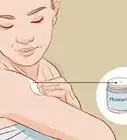This article was co-authored by Diana Yerkes. Diana Yerkes is a Skincare Professional and the Lead Esthetician at Rescue Spa in New York City, New York. With over 15 years of experience, Diana helps others with their skin care needs by incorporating natural and high-performing products and treatments into their routines while providing nutrition insights and educating clients on better skin care habits. Diana is a member of the Associated Skin Care Professionals (ASCP) and holds certifications from the Wellness for Cancer and Look Good Feel Better programs. She received her esthetics education from the Aveda Institute, the International Dermal Institute, and the Biologique Research Academy.
There are 9 references cited in this article, which can be found at the bottom of the page.
This article has been viewed 131,449 times.
Hyaluronic acid occurs naturally in your body and helps retain moisture in the skin and repair the skin’s natural barriers.[1] As you age, the amount of hyaluronic acid produced depletes causing your skin to lose moisture, so it’s important to replenish it. By choosing the correct hyaluronic acid products or treatments and applying them properly, you can rejuvenate your skin and return it to its former glory.
Things You Should Know
- Hyaluronic acid is a substance that helps your skin retain moisture and while it occurs naturally in your body, your hyaluronic acid levels slowly deplete over time as you get older.
- Topical creams, serums, and moisturizers that contain hyaluronic acid are all generally going to be good for your skin so long as they don’t contain alcohol, sulfates, phthalates, or other ingredients that can damage or dry out your skin.
- Hyaluronic acid is also available in an injectable gel form as a filler, which is a phenomenal option if you have chronically dry sky; you’ll need to see a dermatologist to get one of these treatments, though.
- Injectable hyaluronic acid fillers are exponentially more efficient than topical products because the acid needs to reach the lower layers of your skin to replenish it, and topical products don’t go that deep.
Steps
Choosing a Hyaluronic Acid Serum
-
1Buy a serum with a mix of molecule sizes to penetrate the skin. Hyaluronic acid molecules are normally too large to pass through the layers of the skin.[2] You’ll want to find a product that provides a variety of molecule sizes to get better benefits from topical application.
- Lower molecular weights can go deeper into the skin.
- Not all products list these, so it’s best to research online or ask the manufacturer for more details.
-
2Use a water-based serum if you have oily/combination skin. This will help you avoid introducing too many unnecessary oils to your skin.[3]Advertisement
-
3Find a water or oil-based serum for dry/normal skin. Topically applied, oil-based products will hold water on your dry skin’s surface and hydrate cells without blocking pores.[4]
-
4Test your product first to see if your skin reacts. Apply hyaluronic acid somewhere discreet, like behind your ear to test the effect on your skin.[5] It is unlikely to cause a reaction as it occurs naturally in the body.
- Use once per day or every other day initially to ensure it’s safe in the long term
-
5Cleanse and tone your face as you normally would. Follow your regular skin cleansing routine up until before you add moisturizer.[6]
-
6Apply a thin layer of hyaluronic acid serum to damp skin. Having moisture already on the skin allows your choose hyaluronic acid serum to be absorbed better. Hyaluronic acid works by retaining moisture, so you’ll need to give it something to work with.[7]
-
7Use hyaluronic acid serum in the morning and at night. In the morning, it can give your skin additional moisture to soften it throughout the day. Used at night time, hyaluronic acid will help replenish the moisture lost during your day’s activities.[8]
Using a Hyaluronic Acid Cream
-
1Choose a hyaluronic acid cream to lock in moisture. Since moisturizing creams sit on the surface of the skin, they work to hold moisture within the skin’s surface. Adding hyaluronic acid moisturizer to your existing skincare regime will give you the best results from your hyaluronic acid treatment.[9]
-
2Look for a concentration of at least 0.1% hyaluronic acid in your cream. Any less than this and you’ll reduce the effectiveness of the moisturizing cream. Studies show that this level of hyaluronic acid is effective for hydrating skin and maintaining skin elasticity.[10]
- If you have sensitive skin, you may want to keep to lower strength hyaluronic acid formula so you don’t risk a reaction or dryness.
-
3Add hyaluronic acid to your existing moisturizer. If you have a moisturizer that works for your skin already, simply add hyaluronic acid to this to utilize its benefits.[11]
- Research the ingredients in your product to ensure you’ll achieve the correct concentration of hyaluronic acid.
-
4Apply as often as required. It is safe to use hyaluronic acid every time you follow your skincare routine. This will depend on your individual routine and requirements, but the addition of hyaluronic acid will not affect these timings.
Getting Hyaluronic Acid Fillers
-
1Consult a dermatologist to use hyaluronic acid for healing skin. If you’re looking to heal lines or scars, ask a medical professional about hyaluronic acid dermal filler injections. Since this allows the hyaluronic acid to penetrate beneath the first layers of skin, it is a more effective way to heal skin on a molecular level.[12]
-
2Choose a licensed healthcare provider. Do your research beforehand and ask about their experience with dermal injections, and discuss treatment options before going ahead with hyaluronic acid filler treatments. Ensure they are using approved substances, depending on your region’s laws.
-
3Know the risks of dermal fillers. Side effects of hyaluronic acid fillers include redness, swelling, itching and pain at the injection site. In rare instances, you may experience more serious side effects, so it is important to discuss this with your healthcare provider and understand the risks.
Expert Q&A
Did you know you can get expert answers for this article?
Unlock expert answers by supporting wikiHow
-
QuestionIs hyaluronic acid safe for all skin types?
 Diana YerkesDiana Yerkes is a Skincare Professional and the Lead Esthetician at Rescue Spa in New York City, New York. With over 15 years of experience, Diana helps others with their skin care needs by incorporating natural and high-performing products and treatments into their routines while providing nutrition insights and educating clients on better skin care habits. Diana is a member of the Associated Skin Care Professionals (ASCP) and holds certifications from the Wellness for Cancer and Look Good Feel Better programs. She received her esthetics education from the Aveda Institute, the International Dermal Institute, and the Biologique Research Academy.
Diana YerkesDiana Yerkes is a Skincare Professional and the Lead Esthetician at Rescue Spa in New York City, New York. With over 15 years of experience, Diana helps others with their skin care needs by incorporating natural and high-performing products and treatments into their routines while providing nutrition insights and educating clients on better skin care habits. Diana is a member of the Associated Skin Care Professionals (ASCP) and holds certifications from the Wellness for Cancer and Look Good Feel Better programs. She received her esthetics education from the Aveda Institute, the International Dermal Institute, and the Biologique Research Academy.
Skincare Professional
-
QuestionCan I apply hyaluronic acid serum on my lips to make them bigger?
 SapphiaCommunity AnswerHyaluronic acid serum is used to prevent and treat dryness and is not meant for plumping lips. It is unlikely to work, and if it did, it would be temporary. It would be better to buy a product made to enhance the size of lips.
SapphiaCommunity AnswerHyaluronic acid serum is used to prevent and treat dryness and is not meant for plumping lips. It is unlikely to work, and if it did, it would be temporary. It would be better to buy a product made to enhance the size of lips. -
QuestionI feel a little itchiness when I apply hyaluronic acid serum and cream. Is this normal, or should I stop using it?
 Community AnswerStop using it. If you use anything on your face and it itches, burns, or goes red, wash off immediately and stop using, as you may have a slight allergy or sensitive skin.
Community AnswerStop using it. If you use anything on your face and it itches, burns, or goes red, wash off immediately and stop using, as you may have a slight allergy or sensitive skin.
Warnings
- As with all skincare products, if you experience any adverse effects from hyaluronic acid, stop using it immediately and consult a medical professional if symptoms persist.⧼thumbs_response⧽
- Avoid buying dermal fillers online or using them yourself without medical supervision.⧼thumbs_response⧽
- Never get injectable fillers in an unlicensed practice or from an unlicensed provider.⧼thumbs_response⧽
References
- ↑ Diana Yerkes. Skincare Professional. Expert Interview. 16 April 2019.
- ↑ http://barefacedtruth.com/2015/03/31/hyaluronic-acid-yes-size-does-matter/
- ↑ https://www.bodyandsoul.com.au/beauty/news-reviews/water-based-serums-vs-oil-based-serums-which-one-should-you-be-using/news-story/c4fd476a9a87bad5ec6a0830590d10a0
- ↑ https://www.huffingtonpost.com/entry/what-is-hyaluronic-acid_us_569f9978e4b0fca5ba7607f4
- ↑ https://www.refinery29.com/acid-skin-care-by-type
- ↑ Diana Yerkes. Skincare Professional. Expert Interview. 16 April 2019.
- ↑ Diana Yerkes. Skincare Professional. Expert Interview. 16 April 2019.
- ↑ https://www.timelessha.com/blogs/news/how-to-use-hyaluronic-acid-serum
- ↑ http://www.skinacea.com/faq/treatments/t08-hyaluronic-acid-drying.html
- ↑ https://www.ncbi.nlm.nih.gov/pubmed/22052267
- ↑ Diana Yerkes. Skincare Professional. Expert Interview. 16 April 2019.
- ↑ https://www.ncbi.nlm.nih.gov/pmc/articles/PMC2685277/
About This Article
To use hyaluronic acid, start by choosing a serum that works best for your skin type. If you have oily or combination skin, try a water-based serum to avoid introducing too many unnecessary oils to your skin. Alternatively, find an oil-based serum if you have dry or normal skin. Oil-based products will help retain water on the surface of your skin so it's more hydrated. Once you have your product, test it somewhere discreet, like behind your ear, to see the effect on your skin. If you don’t have a reaction, cleanse and tone your face as usual, then apply a thin layer of hyaluronic acid serum to your damp skin to help it absorb better. Use your serum in the morning and at night for the best results. To learn how to use a hyaluronic acid cream, keep reading!

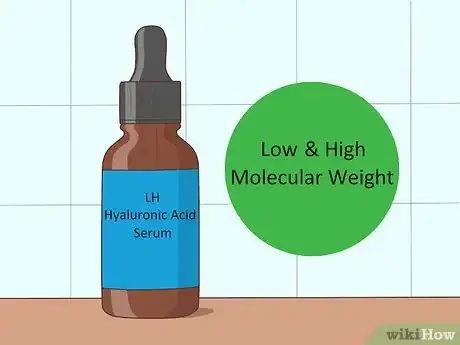
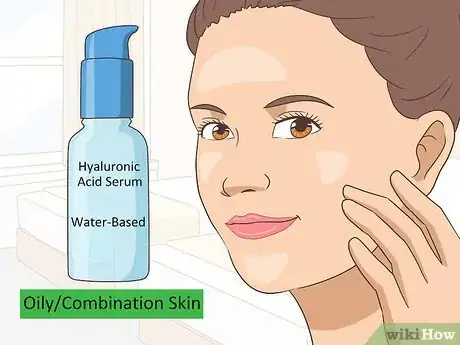


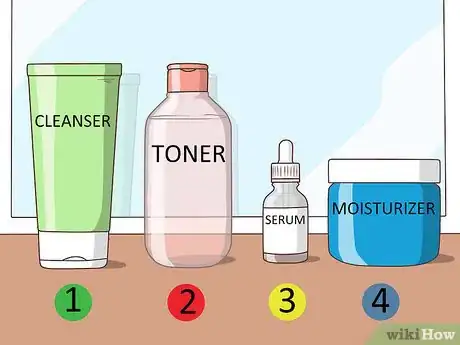



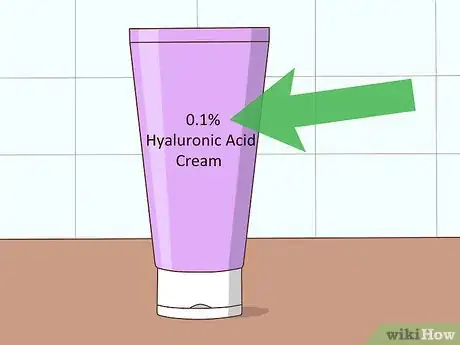
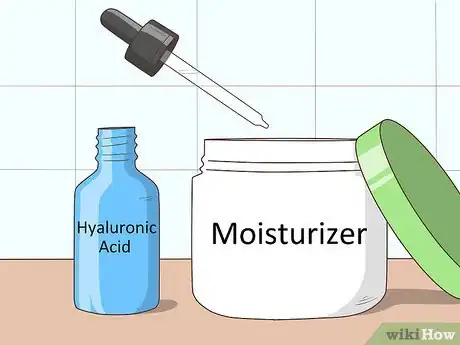
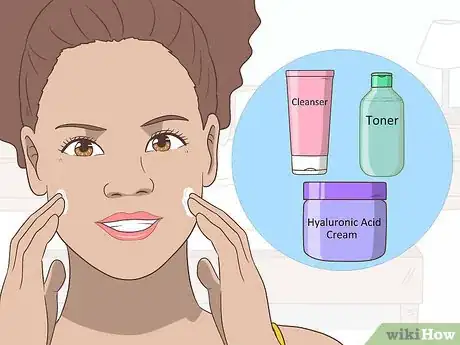









-Step-12-Version-3.webp)














